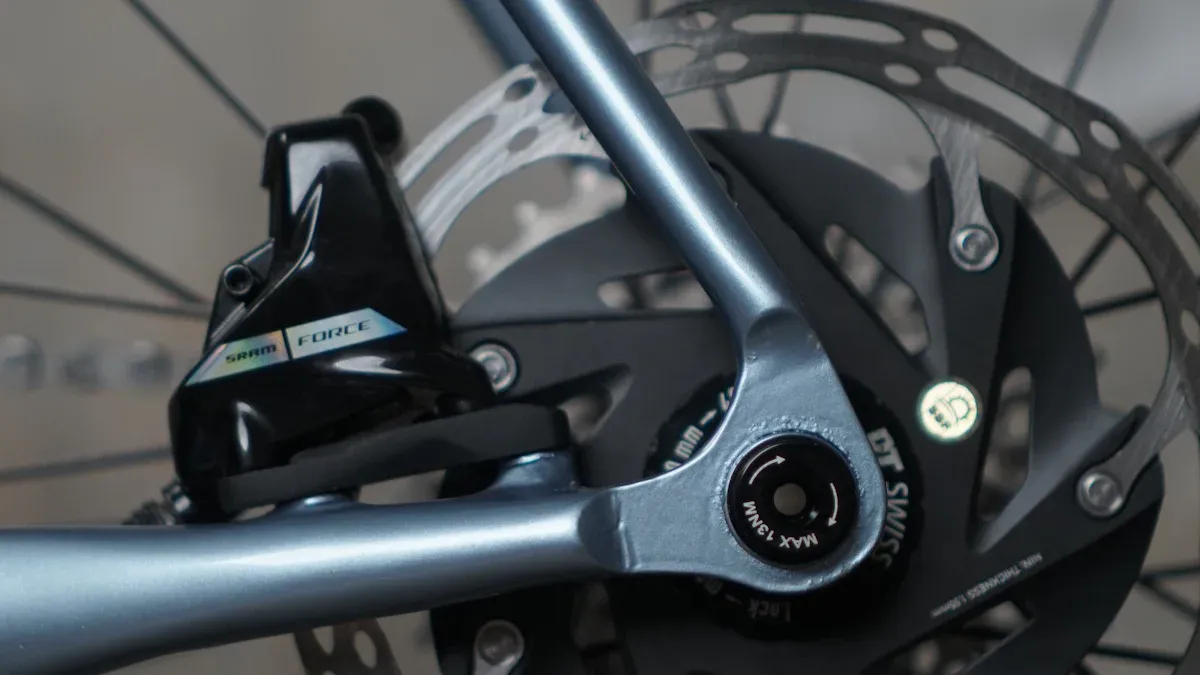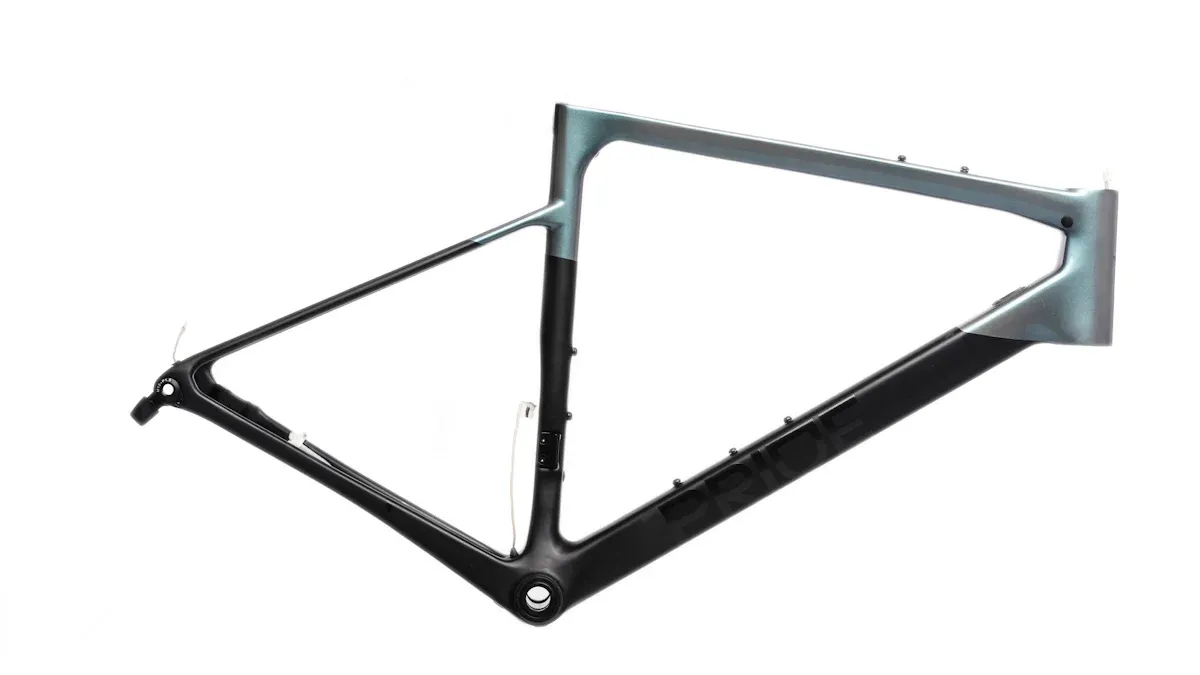
Cyclists are increasingly considering titanium vs carbon bike frames when making their choices. Each material offers unique benefits tailored to different riding styles. When selecting a frame, it’s essential to reflect on your cycling needs. For instance, titanium frames are known for their comfort and strength, making them ideal for long rides. Conversely, carbon frames are lighter and provide excellent handling, which is particularly advantageous for racers. As you contemplate your options for 2025, which frame material will best suit your cycling adventures?
Key Takeaways
Titanium frames are strong and comfortable. They are great for long rides and different weather.
Carbon frames are lighter. They handle well, which makes them popular for racing.
Think about your cycling style and needs when picking titanium or carbon. Each one has its own benefits.
Titanium frames might cost more at first. But they can save you money over time because they last longer.
Both materials are changing with new ideas to make cycling better and more eco-friendly.
Titanium Bike Frames

Titanium bike frames are made from a special alloy. This alloy is strong and light. Many serious cyclists like it because it lasts long and feels comfortable.
Durability and Longevity
When you buy a titanium bike frame, it can last for many years. These frames do not rust and can handle hot and cold weather. They also absorb bumps from the road. This makes long rides more fun. Here’s a quick look at how durable they are:
Metric | Titanium | Steel |
|---|---|---|
Reliability | More likely to break due to defects | More reliable overall |
Rust Resistance | Excellent, does not corrode | Can rust but rare in high-quality frames |
Weight Considerations
Titanium frames are very light, often like carbon frames. For example, the Litespeed’s Toscano FI titanium gravel frame weighs just 1,285 grams. This is lighter than many carbon frames. Being light helps with strength and speed, making titanium good for long rides and races. Here’s a look at the average weights of different titanium bike frames:
Frame Type | Average Weight (grams) | Average Weight (pounds) |
|---|---|---|
Road | 1,480 to 1,660 | 3 lbs, 4 oz to 3 lbs, 11 oz |
Gravel & Cyclocross | 1,510 to 1,810 | 3 lbs, 6 oz to 3 lbs, 13 oz |
Bikepacking & Touring | 1,620 to 1,880 | 3 lbs, 9 oz to 4 lbs, 2 oz |
Cost Analysis
Titanium bike frames have many good points, but they cost more. In 2025, prices for titanium frames can vary a lot. For example, Litespeed frames start at $1,799.25. Some high-end models can go over $6,499. Here’s a look at some popular models:
Model | Price |
|---|---|
SaTir | $6,470.00 |
Occulto AR | $9,708.00 |
Occulto Gravel | $9,708.00 |
Occulto Road | $9,708.00 |
Snob | $6,859.00 |
Ideal Use Cases
Titanium bike frames are great for many types of cycling. They work well for road cycling and gravel riding. Their strength and comfort make them perfect for long trips. You can trust a titanium bike to do well on both rough and smooth roads. For example, the Litespeed Cherohala has more space for tires on unpaved roads while still being fast on paved ones.
Carbon Bike Frames

Carbon bike frames are made from woven carbon fibers and resin. This mix makes them light but strong. Many cyclists like carbon because it performs well and feels good to ride.
Durability and Longevity
Carbon frames are very good at resisting wear. If you take care of them, they can last for many years. But there are some concerns about their durability:
Carbon frames can break if hit hard.
They need careful handling to stay safe.
Damage can cause cracks, which can be serious.
UV rays can harm the resin over time, but new treatments help reduce this problem.
Bending too much can cause layers to separate inside, which affects how stiff they are.
Weight Considerations
One great thing about carbon bike frames is how light they are. They can be up to 70% lighter than steel or aluminum frames. This lighter weight helps with faster starts and higher speeds. Here’s a look at the average weights of some popular carbon bike frames:
Model | Weight (lbs) | Weight (grams) |
|---|---|---|
Lamere Dopamine | 7.2 | 3265 |
ICAN Cycling | 3.35 | 1520 |
Cost Analysis
The price of carbon bike frames can be very different. In 2025, you might pay from $1,999.99 for basic models to $14,999.99 for top models. Here’s a look at the price range:
Price Range | Model Type |
|---|---|
$1,999.99 | Entry-level |
$3,499.99 | Mid-range |
$6,599.99 | High-end |
$14,999.99 | Premium model |
Ideal Use Cases
Carbon bike frames are great for many types of cycling. They are often used in racing because they are light and aerodynamic. Here’s a quick look at where they work best:
Competitive Cycling: Most pro cyclists choose carbon for its speed and handling.
Road Cycling: The light design helps with aerodynamics.
Mountain Biking: Carbon frames are strong and absorb shocks.
Cyclists with carbon frames enjoy a smoother ride. The material helps soak up bumps from the road, which is good for both racers and casual riders.
Titanium vs Carbon Bike Frame Comparison
When you look at titanium and carbon bike frames, think about a few important things: performance, durability, weight, and cost. Each material has good and bad points that can change how you ride.
Performance Comparison
Both titanium and carbon frames have special performance features. Here’s a list of their good and bad sides:
Frame Type | Pros | Cons |
|---|---|---|
Titanium | – Gives a comfy ride | – Not as light as carbon frames |
– Very strong, can take hard hits | – Costs more to make | |
– Lasts a long time, no need to replace often | – Heavier than carbon | |
– Good for the environment (can be recycled) | – Less quick handling than carbon | |
– Looks nice | ||
Carbon | – Lightest option available | – Not as strong as titanium frames |
– Great at absorbing bumps, making rides comfy | – Shorter lifespan, may need replacing more often | |
– Quick control and handling | – More expensive because of shorter lifespan | |
– Quieter ride than titanium | – Not fully recyclable, less good for the environment | |
– Easier to fix | – Limited space for carrying bags (no racks) |
You’ll see that titanium frames give a smooth ride and absorb bumps well. On the other hand, carbon frames are very responsive, which is great for racers.
Durability Comparison
Durability is very important when picking between titanium and carbon. Here are some facts:
A titanium frame can stay in good shape even after riding over 100K miles without cleaning.
With good design and assembly, titanium is likely the strongest material.
A well-made titanium bike can last for many years, as shown by what owners say.
Feature | Titanium Bikes | Carbon Fiber Bikes |
|---|---|---|
Durability | Very strong, best metal, doesn’t rust | Light but weaker than titanium |
Long-Term Cost | Cheaper over time because it lasts long | Costs more at first, but repairs are easier and cheaper |
Titanium frames can last 50-100 years, while carbon frames usually last only 4-8 years. This big difference in how long they last can help you decide, especially if you want a bike for a long time.
Weight Comparison
Weight is very important for how you ride. Here’s how titanium and carbon stack up:
Weight matters for cyclists who care about performance and climbing.
Carbon frames are usually lighter than titanium, helping speed and climbing for racers.
New titanium frames have gotten better and can weigh the same as carbon frames, which is good for those who want durability.
You might find that titanium frames can now weigh the same as similarly priced carbon frames, making them a good choice for cyclists who care about weight.
Cost Comparison
Cost is often a key point for many cyclists. Here’s a look at the prices for both materials:
Frame Material | Entry-Level Price | High-End Price |
|---|---|---|
Titanium | $1899 & up | $600 to $1000 drop in top-level frames |
Carbon | Over $1200 | Up to $13000 |
Titanium frames start at $1899, while entry-level carbon fiber frames cost over $1200. High-end carbon models can go up to $13,000, making titanium a better deal over time because it lasts longer.
Future Trends in Bike Frame Materials
Innovations in Titanium
Titanium bike frames are changing quickly. Companies are adding new features that make them better and more eco-friendly. Here are some important updates:
Innovation | Description |
|---|---|
This special carbon seatmast is shaped like a D. It helps adjust the bike and is lighter. | |
Titanium Plug and Collar Setup | This custom-made joint system improves how the bike works while keeping high quality. |
Precision CNC Componentry | Parts made in-house ensure they are strong and last a long time. |
Ultra-Butted Titanium Tubing | Thinner walls make the frame lighter but still give a good ride. |
Clean, Purposeful Routing | Hidden cables with a T47 bottom bracket make the bike stiffer and easier to fix. |
These updates not only make riding better but also care for the environment. Companies like IperionX and Canyon Bicycles are teaming up to create bike parts from low-carbon, recycled titanium. They want to make bike parts, including frames, using 100% recycled titanium. This helps cut down on waste and makes titanium production better for the planet.
Innovations in Carbon
Carbon bike frames are also getting better. Here are some key improvements:
Advancement Type | Description |
|---|---|
These changes make the frame stronger and lighter, which helps it perform better. | |
Automated Manufacturing Processes | These methods make production faster and more accurate, which lowers costs. |
Advanced Materials Integration | New materials make the frame tougher and better at handling impacts, increasing its lifespan. |
However, making carbon fiber has environmental issues. It creates over 50 kg of CO2 for every kg produced, which is a lot. Recycling carbon fiber is harder than recycling aluminum and steel. To solve this, people are looking at new materials like BioFiber and flax fibers. These materials are strong and have a smaller carbon footprint. It’s important to recycle old carbon fiber bike frames to reduce waste and help create a circular economy.
In conclusion, titanium and carbon bike frames have their own benefits. Titanium frames are strong and comfy, which is great for long rides. Carbon frames are lighter and more responsive, which is good for racers. Your choice should match your cycling goals and likes. Think about how you will use your bike. Whether you want it to last long or perform well, knowing these differences will help you decide better.
FAQ
What is the main difference between titanium and carbon bike frames?
Titanium frames are strong and comfortable. Carbon frames are lighter and respond better. Your choice should match your riding style and what you like.
Are titanium bike frames worth the higher cost?
Yes, titanium frames last a long time and need fewer replacements. Their strength can make them a smart buy over time, especially for serious riders.
How do I maintain my carbon bike frame?
To take care of a carbon frame, check it often for cracks or damage. Clean it with mild soap and water, and avoid strong chemicals. Keep it out of direct sunlight to stop UV damage.
Can I repair a damaged carbon frame?
Yes, you can fix a damaged carbon frame, but you need a professional. Many bike shops can repair carbon frames to keep them safe and working well.
Which frame is better for long-distance cycling?
Titanium frames are usually better for long rides because they are comfortable and absorb shocks. They give a smoother ride on rough roads, making them great for endurance cycling.
See Also
A Guide to Evaluating Carbon Race Bike Frames Effectively
Understanding the Unique Features of Titanium Bike Frames
The Reasons Cyclists Prefer Carbon Bike Frames in 2025
